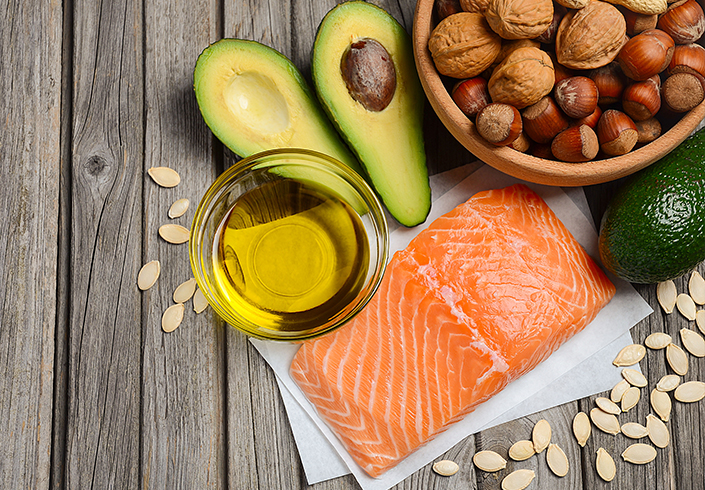Keto diets trigger a process called ketosis. This process is when the body uses something called ketones or ketone bodies as its primary energy source instead of glycogen – or stored carbohydrate, when little glycogen is available. A ketosis state can be achieved through strict ultra low carb – ketogenic diets and maybe an effective means of burning body fat off quickly, that is if you can stand being on the diet! Curious if this type of diet is for you? Keep reading.
What are Ketones?
Before we can talk about the benefits of ketosis and its effectiveness, you need to understand some of the chemistry behind this diet. Ketosis requires the production of Ketones, Ketone bodies or K-bodies. These compounds are the fuel source that gets utilized instead of glycogen when glycogen levels are depleted, as a result of a strict diet, fasting or even during prolonged exercise. K-bodies are produced by the liver and are subsequently used by the muscle, but also the brain and heart as an energy source when required.
Decisions, Decisions… When Does the Body Switch to K-Bodies?
Getting to a state of ketosis, where the body is producing K-bodies for energy production can only occur by following a diet that is extremely high in fat, low in carbs and protein. That’s right – low in protein. Traditional ketogenic diets are high in fat (80% of daily energy intake), low in carbohydrates (20 to 50 g or 5% or less of your calorie intake) and moderate to low in protein intake (15% of daily energy intake). Does that even sound healthy? A diet that is composed of 80% fat?
This restriction uses up stored carbs quickly and helps switch the body into ketosis. Following this type of diet for anywhere from 2 to 4 days can result in the state of ketosis. Other factors that can influence how fast you can get into ketosis are the amount of exercise you’re performing, the type of exercise, and how much and what you’re eating. For example, fasting can greatly increase ketone production, but so can high intensity exercise that depletes glycogen quickly.
The Biochemistry of Ketosis…
When levels of glucose and insulin fall, this causes an increase in the release of free fatty acids or fat from the liver – lipolysis. The result, the accumulated free fatty acids get converted into usable K-bodies that can serve as an alternative energy source in the mitochondria – the powerhouse energy generating cells. K-bodies cross the mitochondrial membranes by transporters and are converted back to acetyl-CoA that can then be used as an alternative source of energy in the Citric Acid Cycle (TCA) also known as the Kreb’s Cycle – the major metabolic pathway that produces the body’s main source of energy – ATP. This energy molecule fuels your muscles and helps drive your workouts. Typically this cycle is driven primarily by glucose molecules. In fact just one molecule of sugar results in 38 molecules of ATP! That’s a lot of available energy to power workouts. Producing energy other ways is not only counterintuitive its, energy costly on the body.
The Downfall of Ketogenic Diets…
It may seem like a super easy diet to follow – limit carbs, burn fat. But in actuality, ultra strict low carb diets can greatly impact exercise training intensity, limiting your performance and strength – particularly during moderate to high intensity exercise such as HIIT, cross fit, mixed martial arts training, or pretty much any exercise that requires a high degree of conditioning and endurance.
It has also been shown, that those who respond best to a ketogenic diet are highly trained individuals, basically anyone that is already accustom to exhausting their muscles and are already efficient at using K-bodies as fuel instead of glycogen in extreme depleted situations – such as marathon athletes or cyclist. In addition, side effects of following a ketogenic diet for prolonged periods also include severe carb cravings, brain fog, fatigue, depressed mood, sleep loss – lack of carbs can result in lower serotonin production, but also a big one – muscle loss due to protein oxidation – or the breakdown of muscle as fuel, particularly if you’re lean to start with.
Combining a ketogenic diet that is low in calories and protein, can result in a shut-down of the very pathways that are necessary to make muscle. It was shown that lowered protein levels reduce the activity of the key pathways involved in protein synthesis including mTOR. When this pathway is turned off muscle building, muscle repair and recovery can’t happen. Therefore, following a ketogenic diet can also, lead to a downshift of not just your happy hormones but the anabolic – muscle building ones too. Top that with sleep loss and increased cortisol levels, could result in the loss of your hard earned muscle!
What’s worse, eating that much fat in the diet has also been shown to result in fat accumulation in the body, resulting in you guessed it – storage of more fat – the very thing you’re trying to get rid of!
Benefits of Ketogenic Diets…
Ketogenic diets if followed for limited periods of time can be very effective for reducing that last bit of fat you’ve been holding on to. Many physique competitors will use a version of a ketogenic diet in their last few weeks of show prep to get down to that ultra lean, ripped state, but sticking long-term is not only not necessary it will not give you better results. A better method – a modified version ultimately provides more protein and less fat to help hold on to your muscle and keep your hormones at an ultimate level for muscle building, especially during depleted, low calorie states that occur during pre-competition diets.
Ketogenic diets can also be highly effective if you’re holding on to a lot of extra fat weight, as there is something for the body to utilize as a fuel source without going to your hard earned muscle. However, if you’re body is very efficient at using carbs, your workouts are extremely high endurance, you’re lean and you don’t do well with brain fog or have a job that requires thought, you may want to consider something else – such as a carb cycling diet or a modified ketogenic diet, whereby protein makes up 40 to 50% of your daily calories, carbs provide around 20% or less and fat between 30 to 40%. This more balanced approach is more sustainable and also comes with great result.
Tips for Building a Modified Ketogenic Diet
- Stick to carbs that are complex in nature. Avoid simple carbs like white rice, bread and pasta. Stick with carbs that provide a good source of fiber and take a longer time to digest such as vegetables and whole grains. These carbs will reduce blood glucose spiking and help direct the body to utilize available energy first.
- Eat plenty of vegetables including leafy greens, fresh and raw, or steamed and roasted. Vegetables provide soluble fiber, phyto-nutrients, vitamins and minerals that help cleanse the body, but also fill us up, reducing hunger between meals.
- Choose lean sources of protein that provide all the essential amino acids that are needed by the body to build and repair muscle. Vary your protein choices including chicken, beef, fish, whole eggs, cottage cheese, grass-fed dairy, green pea protein, quinoa and even beans.
- Add good fats from a wide variety of sources to ensure you get a mix of both polyunsaturated and monounsaturated sources from foods such as olives, nuts, seeds, avocados, whole eggs and fatty fish.
Modified Ketogenic Diet Macros
Protein 40 to 50%
- Lean Beef
- Fatty Fish – Salmon, Tuna
- White Fish – Sole, Haddock, Tilapia
- Chicken
- Turkey
- Whey Protein
- Greek Yogurt
- Cottage Cheese
- Whole Eggs
Carbs 20%
- Sweet Potato
- White Potato
- Squashes – Pumpkin, Zucchini, Butternut, Acorn
- Leafy Greens
- Cruciferous Vegetables – Broccoli, Cauliflower, Kale
- Quinoa
- Beans
- Legumes
- Brown Rice
Fats 30 to 40%
- Avocado
- Olive Oil
- Flax Oil
- Coconut Oil
- Natural Nuts & Nut Butters
- Seeds
Build Your Own Modified Keto Diet…
Breakfast
3 Whole Egg Omelette with Veggies, 1 oz Feta Cheese and 100 g Pumpkin Mash
Snack
150 g Full Fat Greek Yogurt with Spoonful of Blueberries
Lunch
150 g Chicken Breast with Leafy Green Salad, Olive Oil and Vinegar Dressing
Snack
1 tbsp Almond Butter with Green Apple
Dinner
200 g Salmon, 100 g Sweet Potato, 150 g Steamed Broccoli
Modify it Like a Boss…
In reality, a balanced diet is a far better way to go when it comes to getting results and keeping results. Leave the ultra-restrictive diets to those times when you’re looking to lean out your body for beach season, a vacation or some reason that requires you to look your leanest in the shortest possible amount of time. Limit a strict ketogenic diet to a maximum of 2 to 3-weeks and the rest of the time, follow this less restrictive approach to maintain a healthy metabolism and a good amount of muscle too.




Leave a reply